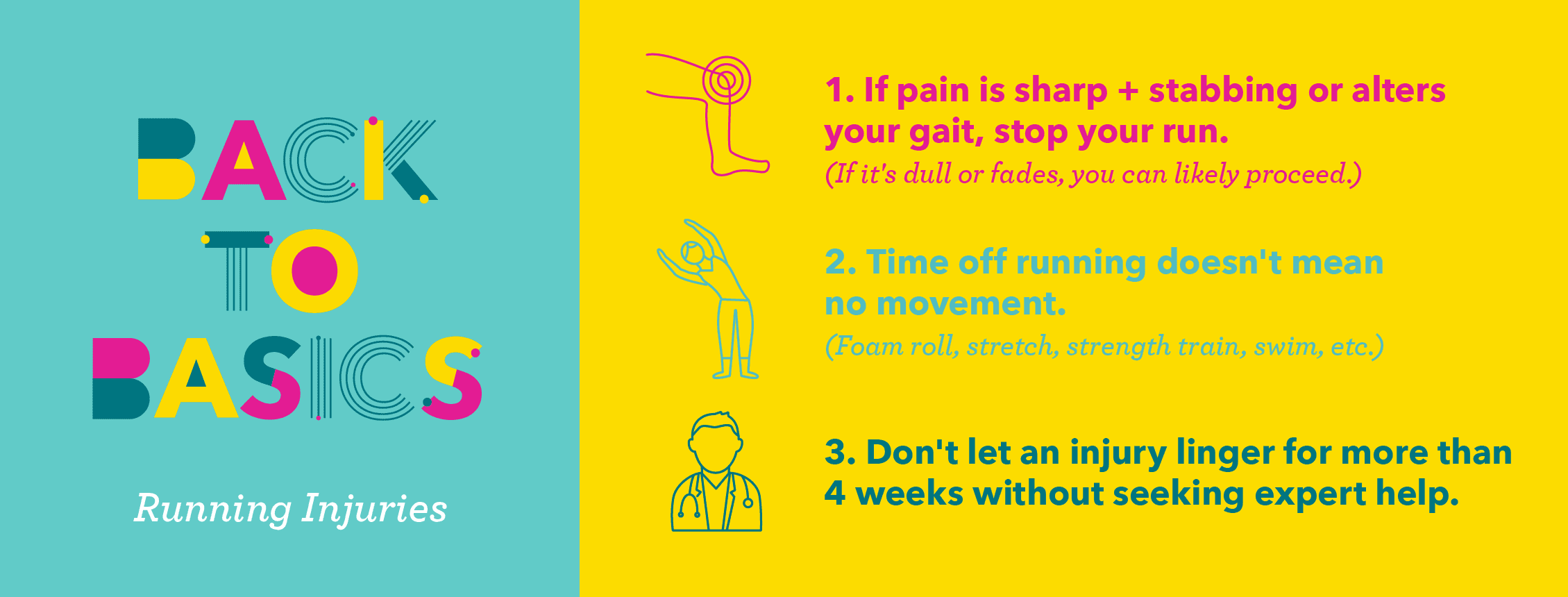
By Christy Diller, PT
While there are miles of articles that dig into stress fractures and plantar fasciitis and the details of specific running injuries, we want to zoom out and lay out the basic steps you should consider as you feel a niggle or an ache on a random Tuesday morning run.
Follow the questions below to do the right thing for your body—and your running career.
1. You feel a niggle, ache, pain, etc. Should you stop running immediately?
The answer is no if…
—you notice pain at the beginning of the run, but it gets better, you are probably fine to keep running on it. Continue to monitor it during the day.
—you notice pain that is more dull in nature—it’s just “there”—you can likely finish the run. Continue to monitor it during the day.
The answer is yes if…
—the pain is sharp and stabbing. And it doesn’t get better—or actually gets worse—during a run.
—the pain hinders your run in any way; you’re adjusting your typical form, gait, distance because of your injury.
If you answered yes, take a couple of days off.
#1a: How do you feel later in the day?
If the pain lingers as you walk, sit, drive, or do other non-running-related movements, it’s time to take a break from running for a few days.
#2: Ok, I need to take a couple days off. What does that look like?
Take at least one full day away from activity, but then it’s time to move again.
A few ideas to try:
Tight muscles can definitely benefit from a foam rolling session (or a massage, if you have the time and funds!).
Your body might also benefit from basic physical therapy moves; either ones that you have been given previously by a PT, or basic moves like ones in this hip strengthening videos.
If you want a cardio fix, try biking, walking, elliptical, yoga/pilates, swimming, rowing: anything low- or non-impact that doesn’t exacerbate the pain.
Basic stretching moves might also feel good.
It will likely make you feel better to google “inside of left knee hurts while running” or your specific situation, so spend a little time doing that. But emphasis here is on little: don’t go down the rabbit hole of hours of research. Instead, do a basic search, then get on the floor and try the suggestions for a few days.
[Need an assist with the mental side of running injuries? Chronic Running Injuries: 9 Ways to Cope]
Step 3: I’ve taken 2-4 days off and want to try running. How should I proceed?
Not with intervals, hill repeats, or anything else intense.
A mistake I often see is for runners to take a few days totally off, then they jump back into running their regular training schedule.
The best thing to do after a few days off is an easy, test-the-waters run, rather than a “I haven’t worked out for 4 days and now I want to kill it” run!
Here’s how to test the water: head out for 20-30 minutes at an easy, peasy pace. If you want to do a run/walk combo, have at it. Tune into your body, not your GPS.
Step 4: I just tried running again, and the pain snapped back like a slingshot. Dang it.
Time to answer two more questions:
1. Do you have an event coming up?
2. Do you need to move for your mental health—and currently can’t do that pain free?
A “yes” to either of those means you should call in some professional help sooner than later. You may need to start with your doctor to get a recommendation for a physical therapist; check with your insurance. If you’d rather not go the straight medical route, consider a chiropractor or a massage therapist who works with runners. They can often get you pointed in the right direction.
If you answered no to the above questions—and have the time and bandwidth to work on it on your own—then give yourself 2-4 weeks of managing it on your own. This would mean backing off on your mileage (either run for fewer days or cover less actual distance) and continuing with the self- management options noted above. If you can’t run: give it a week or so, then try again.
If, after four weeks, things haven’t improved much, it’s time to get it looked at. When you go over four weeks, you run the risk of the injury going from an acute issue to more of a nagging, here-to-stay problem.
Step 5: Ok, I’ve been diligent about recovery and things are getting better. (Amazing how that works!) How do I avoid future injuries?
Don’t just do things the way you’ve always done them!
In order to avoid running injuries, routines need to be constantly evaluated and freshened up.
Even if you were able to run 40 miles a week—or do speedwork twice a week or average 9:30 splits—a year ago, that doesn’t mean you can still do that. You may have another kid, you may be sitting more, have more duties/responsibilities at home or work; the list can go on and on. What may have merely made you sore six months ago may now require much more recovery and can dissolve quickly into an actual injury.
Stress is stress, your body can’t tell if that stress is due to a hard workout or not getting enough sleep for weeks on end. It all adds up!
[Also consider that MAYBE the way you were doing it wasn’t so smart to begin with and you were just able to get away with it!]
Step 6: Got it. What are three other things every (aging) runner should do to avoid running injuries?
#1: Dynamic Warm Up: Don’t just jump right into a run; take a little time to get your tissues warmed up first!
#2: Cool down after your run. Not a huge commitment; take an easy walk for 2-3 minute after a run, walk backwards for 1-2 minutes, and add in some some easy gentle stretching if you’d like.
#3: Vary the input. Make sure you are changing up the total distance/effort/terrain so not every run is exactly the same!
[Ready to return (safely) to running after a prolonged injury? Our Return to Running program is exactly what you need.]






I have recently had an MRI taken of my left knee as I have been experiencing some weakness in my lower leg and hip area. MRI showed “complete tear in lateral meniscus at the horn”. This would involve some discomfort or pain, right? I have NO pain in the lateral area of my knee. I am ignoring the MRI for now. Medicine is not always correct!
physician mother runner. you are correct. that should be causing knee pain. if you are having weakness, i would be investigating your spine…
Cheryl, sorry to hear about your leg weakness, BUT you are right on! MRI does not always tell the whole story! If the knee feels good, I’d file that as INFORMATION 🙂! Good luck 🍀
Plantar Fasciitis is the worst thing I’ve had to struggle through as a runner. Any advice or tips to ease the pain and heal faster would be greatly appreciated!
Hi Sarah, if you haven’t tried it maybe look into ASTYM therapy? It is sort of like Graston but MUCH gentler! ( and not so painful!) You can search their website for providers. I’ve seen great results with it! Hang in there…PF stinks!
This was such a FANTASTIC podcast episode and I LOVE this summary, Dimity! Such great, thoughtful advice that Christy gave. I love the practical application. I ran a race this weekend and after the finish line walked backward to the banana station! LOL